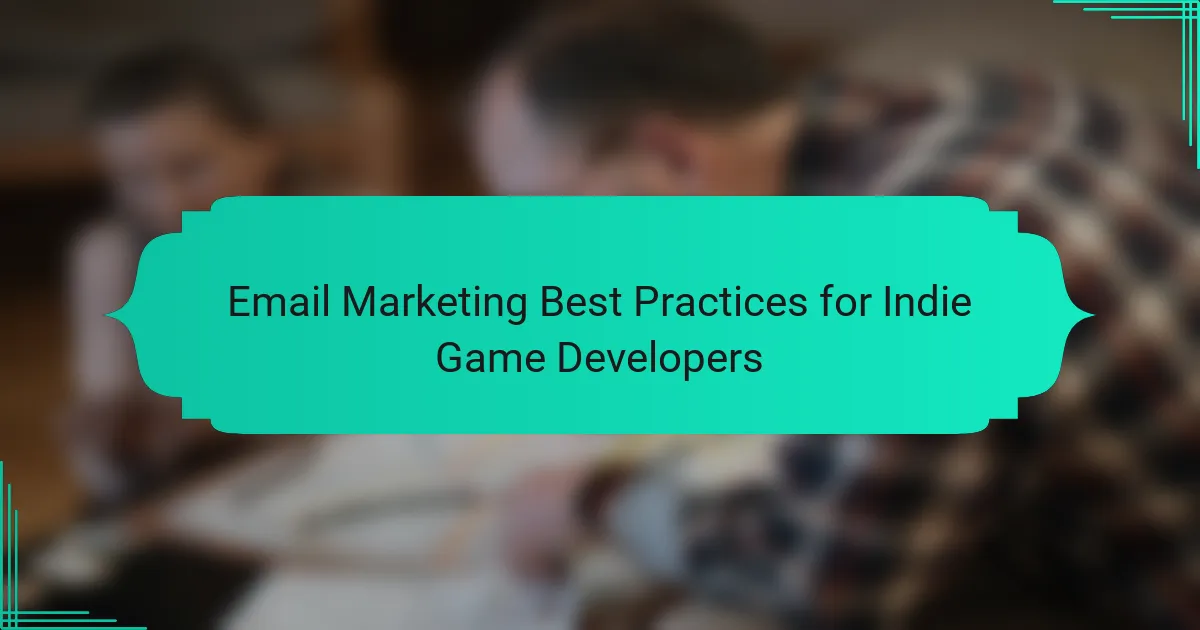Email marketing is a powerful tool for indie game developers to connect with fans and boost sales. This article explores essential strategies for building an email list, crafting engaging content, optimizing send times, and measuring campaign success. It also highlights effective platforms like Mailchimp and Sendinblue, while addressing common pitfalls to avoid in email marketing.
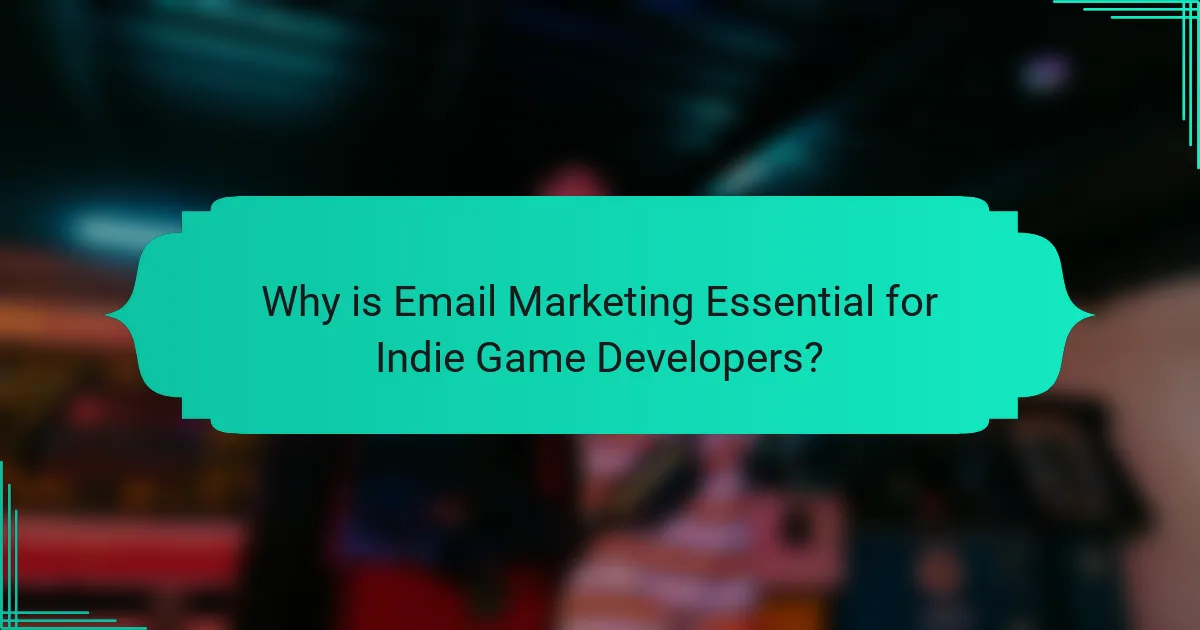
Why is Email Marketing Essential for Indie Game Developers?
Email marketing is essential for indie game developers as it fosters direct communication with fans and builds a loyal community. It allows developers to share updates, gather feedback, and promote new releases effectively. By leveraging email campaigns, developers can achieve higher engagement rates compared to social media.
A well-executed email marketing strategy can lead to increased sales and player retention. According to studies, email marketing yields an average return on investment of $42 for every dollar spent. This makes it a cost-effective tool for indie developers who often operate on limited budgets.
Building an email list early in the game development process is crucial. It provides a platform for developers to connect with potential players, offering exclusive content and insights. Engaging content, such as behind-the-scenes looks or beta testing opportunities, can enhance subscriber interest and loyalty.
Lastly, segmenting the email list based on player preferences and behaviors enables tailored messaging. Personalized emails can significantly improve open and click-through rates, ultimately driving better results for indie game developers.
What are the Key Benefits of Email Marketing for Indie Games?
Email marketing offers indie game developers several key benefits. It enables direct communication with a targeted audience, fostering community engagement and loyalty. Additionally, it allows for personalized marketing, which can significantly enhance player retention and conversion rates. Email campaigns can also be cost-effective, providing a high return on investment compared to other marketing channels. Finally, analytics from email marketing help developers understand player preferences, guiding future game development and marketing strategies.
How Does Email Marketing Differ for Indie Developers Compared to Larger Studios?
Email marketing for indie developers focuses on building personal relationships, while larger studios emphasize broad reach. Indie developers often leverage storytelling and community engagement to connect with their audience, whereas larger studios utilize data-driven strategies for segmentation and targeting.
Indie developers may have limited resources, leading to more creative and authentic campaigns, while larger studios can invest in advanced marketing tools and analytics. Additionally, indie developers often prioritize direct feedback from their audience, fostering a sense of community and loyalty that larger studios may struggle to achieve.
Overall, the approach to email marketing varies significantly based on the scale and resources available, influencing strategy and execution.
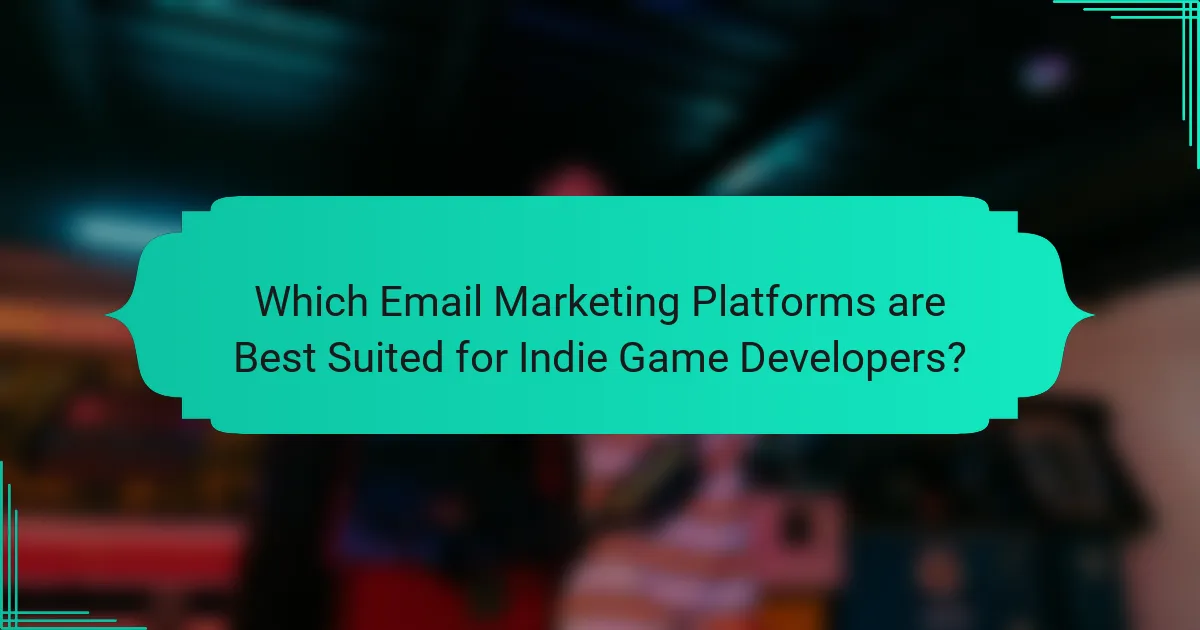
Which Email Marketing Platforms are Best Suited for Indie Game Developers?
Mailchimp, Sendinblue, and Constant Contact are among the best email marketing platforms for indie game developers. These platforms offer user-friendly interfaces, automation features, and analytics tools tailored for engaging audiences effectively.
Mailchimp provides a free tier and customizable templates, making it ideal for startups. Sendinblue excels in transactional emails and SMS marketing. Constant Contact offers extensive support and event marketing tools, which can be beneficial for game launches.
Choosing the right platform depends on specific needs such as budget, desired features, and audience engagement strategies.
What Features Should Indie Developers Look for in Email Marketing Tools?
Indie developers should prioritize user-friendly interfaces, automation features, analytics capabilities, and integration options in email marketing tools. These features streamline campaigns and enhance engagement.
User-friendly interfaces simplify the design process, allowing developers to create attractive emails without extensive technical skills. Automation features enable timely communication, such as welcome emails or reminders, improving user retention. Analytics capabilities provide insights into open rates and click-through rates, helping developers refine strategies. Integration options with game distribution platforms or social media enhance outreach and audience targeting.
How Do Pricing Models Vary Across Different Email Marketing Platforms?
Pricing models for email marketing platforms vary significantly based on features and target audiences. Indie game developers often find tiered pricing, pay-as-you-go, and freemium models that cater to their budget and needs.
| Pricing Model | Description | Ideal For |
|———————|————————————————–|——————————–|
| Tiered Pricing | Different plans based on subscriber count or features | Growing studios |
| Pay-as-you-go | Charges based on the number of emails sent | Small developers with variable needs |
| Freemium | Basic features for free, with premium upgrades | New developers testing waters |
| Subscription | Monthly or annual fees for full access | Established teams seeking consistency |
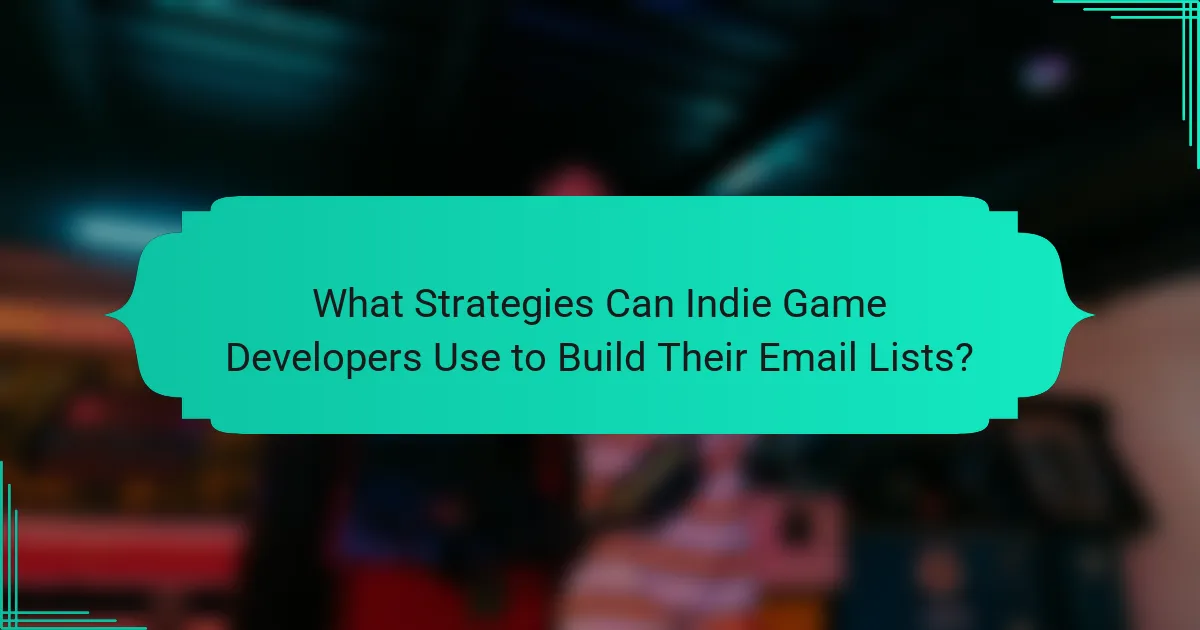
What Strategies Can Indie Game Developers Use to Build Their Email Lists?
Indie game developers can effectively build their email lists by implementing targeted strategies. First, offer exclusive content, such as behind-the-scenes access or early game demos, to incentivize sign-ups. Second, utilize social media platforms to promote sign-up forms and engage potential players. Third, create an appealing landing page that clearly outlines the benefits of joining the email list. Lastly, leverage partnerships with other developers or influencers to reach broader audiences and encourage list growth.
How Can Developers Leverage Social Media to Grow Their Email Subscribers?
Developers can grow their email subscribers through strategic social media engagement. Sharing exclusive content, such as behind-the-scenes looks or early access to game features, encourages followers to subscribe. Utilizing compelling calls-to-action in posts and stories can further drive sign-ups. Collaborating with influencers in the gaming community can expand reach and enhance credibility, attracting more subscribers. Regularly promoting newsletter benefits, such as exclusive updates or special offers, reinforces the value of signing up.
Which Incentives are Most Effective in Encouraging Sign-Ups?
Offering incentives such as exclusive content, early access, and discounts is most effective in encouraging sign-ups. These incentives tap into gamers’ desires for unique experiences and value. For instance, providing a limited-time discount on game purchases can create urgency, while exclusive in-game items can enhance engagement. Additionally, personalized email campaigns that highlight these incentives can significantly increase conversion rates, fostering a stronger community around indie games.
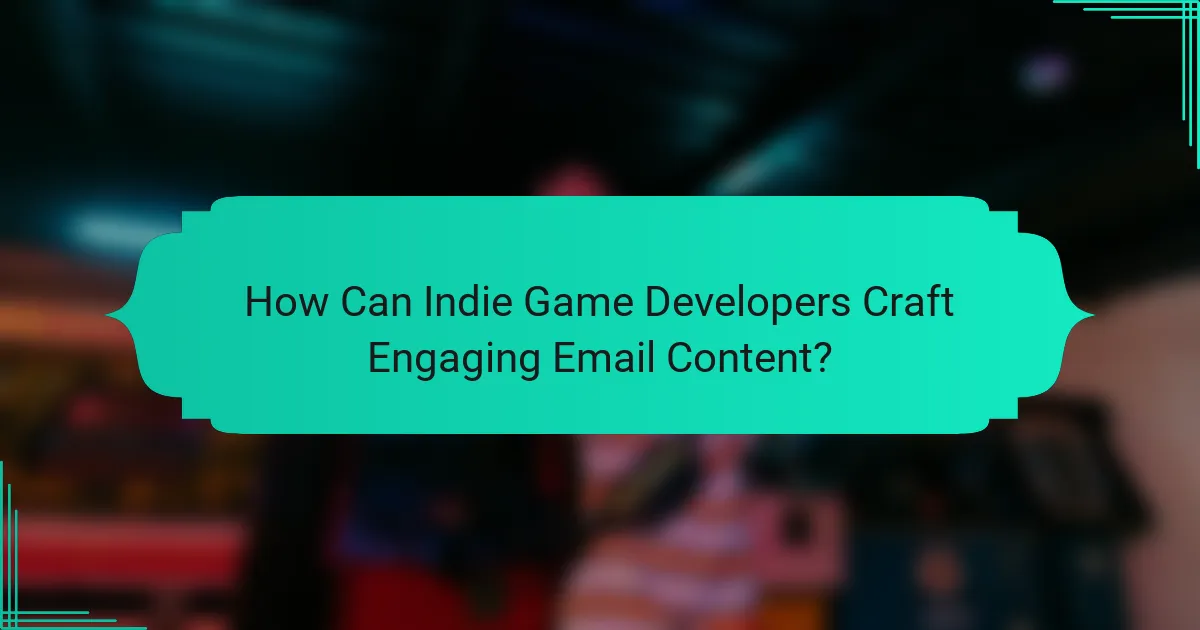
How Can Indie Game Developers Craft Engaging Email Content?
Indie game developers can craft engaging email content by focusing on storytelling, personalization, and clear calls to action. Incorporating captivating narratives about game development journeys can resonate with audiences. Personalized messages that address subscribers by name and tailor content to their interests enhance engagement. Clear calls to action guide readers towards desired outcomes, such as visiting a website or participating in a beta test, increasing conversion rates.
What Types of Content Resonate Most with Gamers in Email Campaigns?
Engaging content types for gamers in email campaigns include personalized offers, game updates, and exclusive content. These elements foster connection and excitement, driving higher engagement rates. Including visually appealing graphics and interactive elements enhances the overall experience. Gamers respond well to community-driven content, such as player spotlights or user-generated content, reinforcing their sense of belonging.
How Should Developers Personalize Emails for Different Segments of Their Audience?
Developers should segment their audience based on preferences and behaviors to personalize emails effectively. Start by analyzing user data to create distinct segments, such as casual players, hardcore gamers, or genre enthusiasts. Tailor email content to each segment’s interests, incorporating relevant game updates, promotional offers, or community events.
Utilize dynamic content to personalize subject lines and email body, ensuring each segment feels addressed. For instance, highlight specific game features that resonate with a segment’s gaming style. Testing different approaches will refine personalization strategies over time, enhancing engagement and conversion rates.
Incorporating feedback from segmented audiences will further improve email relevance. This iterative process allows developers to adapt their communication, ensuring it aligns with evolving player preferences.
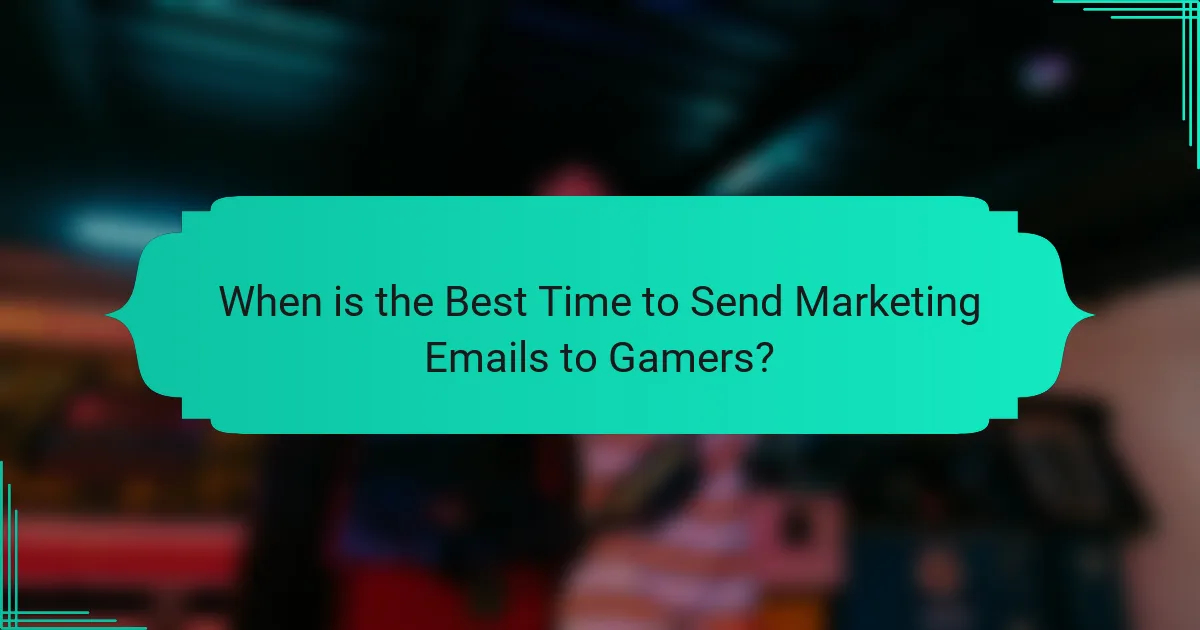
When is the Best Time to Send Marketing Emails to Gamers?
The best time to send marketing emails to gamers is typically during evenings and weekends. Gamers are more likely to engage with emails after work hours and during their free time. Research indicates that emails sent on Thursdays and Fridays see higher open rates, as gamers are gearing up for weekend play. Timing your emails to coincide with game releases or major gaming events also boosts engagement.
What Timing Strategies Have Proven Successful in the Gaming Industry?
Email marketing strategies that have proven successful for indie game developers include timing campaigns around game launches, seasonal events, and player engagement metrics. Sending emails during peak gaming hours can increase open rates. Additionally, segmenting the audience based on gameplay habits allows for personalized messaging, enhancing relevance. Utilizing A/B testing to determine optimal send times further refines effectiveness. Overall, strategic timing aligned with player behavior leads to improved engagement and conversion rates.
How Does Audience Behavior Impact Email Send Times?
Audience behavior significantly influences email send times by determining optimal engagement periods. Analyzing open rates and click-through data reveals when subscribers are most active. For instance, indie game developers may find weekends yield higher engagement due to increased leisure time. Segmenting audiences based on behavior patterns allows for tailored send times, enhancing overall campaign effectiveness. Testing different send times provides insights into audience preferences, leading to improved response rates and conversions.
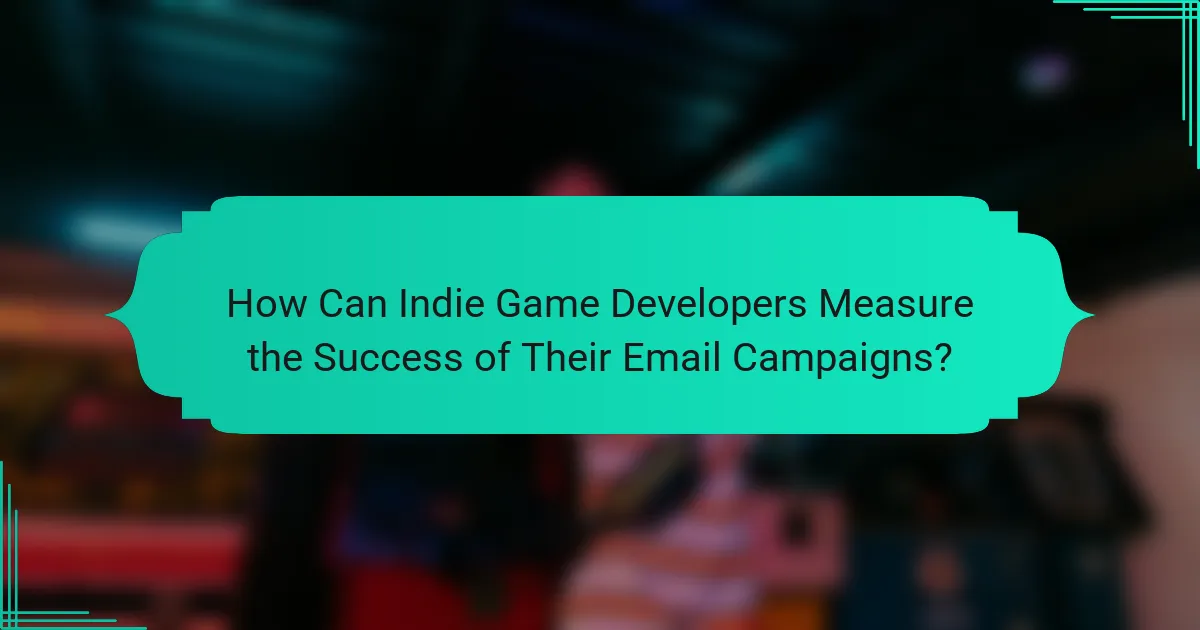
How Can Indie Game Developers Measure the Success of Their Email Campaigns?
Indie game developers can measure the success of their email campaigns through key metrics like open rates, click-through rates, and conversion rates. Analyzing these metrics provides insights into audience engagement and campaign effectiveness. Tracking subscriber growth and feedback can also indicate overall campaign success. Using A/B testing can refine strategies for better results over time.
Which Metrics are Most Important for Tracking Email Performance?
Open rate, click-through rate, conversion rate, bounce rate, and unsubscribe rate are key metrics for tracking email performance. These metrics help indie game developers assess engagement and effectiveness of their campaigns.
| Metric | Description | Importance |
|———————-|——————————————————-|———————————|
| Open Rate | Percentage of recipients who opened the email | Indicates subject line effectiveness |
| Click-Through Rate | Percentage of recipients who clicked on links | Measures content engagement |
| Conversion Rate | Percentage of recipients completing desired actions | Assesses campaign success |
| Bounce Rate | Percentage of emails not delivered | Identifies list quality issues |
| Unsubscribe Rate | Percentage of recipients opting out | Reflects content relevance |
How Can A/B Testing Improve Email Marketing Results?
A/B testing can significantly enhance email marketing results for indie game developers by optimizing content and engagement strategies. By comparing two versions of an email, developers can identify which elements resonate more with their audience, leading to higher open and click-through rates.
For instance, testing subject lines can reveal preferences, while analyzing call-to-action placements can improve user interaction. A/B testing also allows for data-driven decisions, ensuring that marketing efforts align with audience expectations. Regularly implementing this practice can lead to continuous improvement and increased player retention.
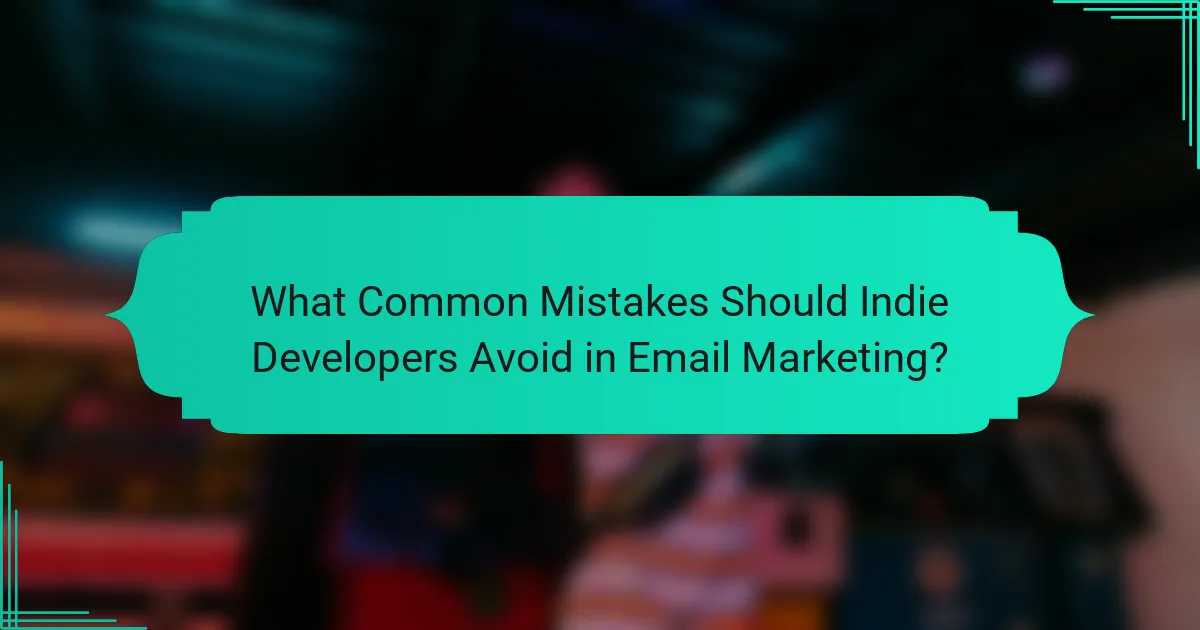
What Common Mistakes Should Indie Developers Avoid in Email Marketing?
Indie developers should avoid common pitfalls in email marketing to enhance engagement and conversion rates. First, neglecting to segment their audience can lead to irrelevant messaging. Second, not optimizing for mobile devices results in a poor user experience. Third, failing to personalize emails diminishes connection with recipients. Fourth, overloading emails with content can overwhelm readers. Lastly, ignoring analytics prevents developers from refining their strategies based on performance data.
How Can Developers Ensure Compliance with Email Marketing Regulations?
Developers can ensure compliance with email marketing regulations by following best practices. First, obtain explicit consent from users before sending emails. Second, provide clear opt-out options in every communication. Third, maintain accurate records of subscriber information and consent. Additionally, adhere to local and international regulations, such as GDPR or CAN-SPAM. Regularly review and update email practices to align with evolving laws. This proactive approach minimizes legal risks and builds trust with the audience.
What are the Risks of Neglecting Email List Maintenance?
Neglecting email list maintenance can lead to decreased engagement and higher bounce rates. This results in diminished effectiveness of email marketing campaigns for indie game developers. Regularly cleaning the list ensures that only interested subscribers receive updates, improving open rates and conversions. Additionally, maintaining a healthy list protects the sender’s reputation and reduces the risk of being marked as spam, which can severely impact future outreach efforts.
What Best Practices Can Enhance Email Marketing Effectiveness for Indie Games?
Effective email marketing for indie game developers hinges on targeted strategies. Building a strong subscriber list, crafting engaging content, and maintaining consistent communication are vital.
Utilize segmented lists to tailor messages based on player interests. This boosts engagement rates significantly. Personalization, such as addressing subscribers by name, enhances connection and encourages interaction.
Incorporate visually appealing designs with clear calls to action. A well-structured email can guide readers towards desired actions, like downloading a demo or joining a community.
Lastly, analyze metrics like open rates and click-through rates to refine future campaigns. Continuous improvement based on data ensures that email marketing efforts resonate with the audience and drive game visibility.
